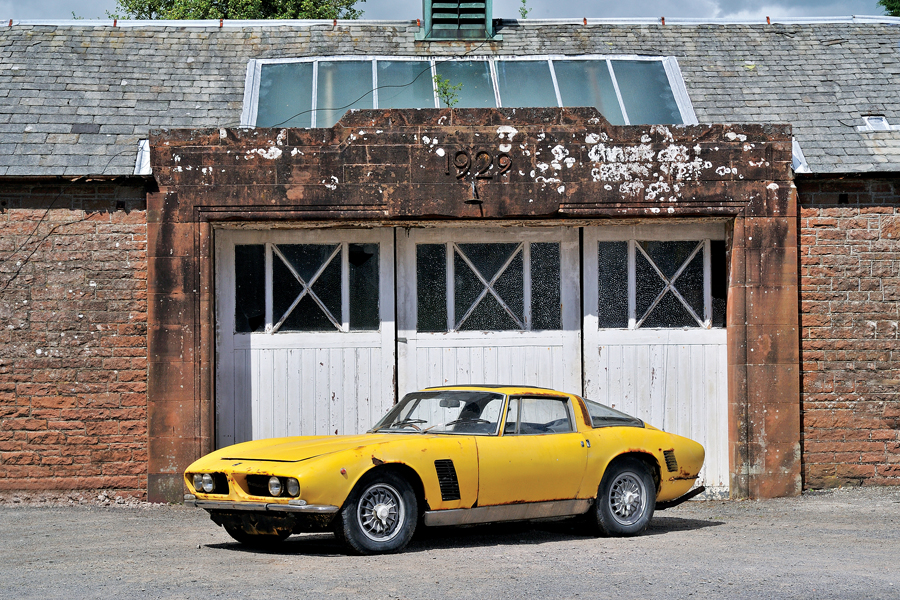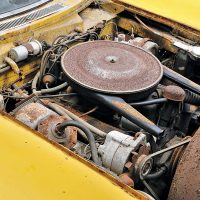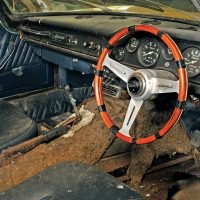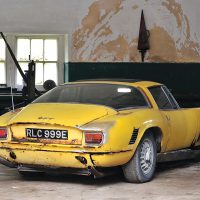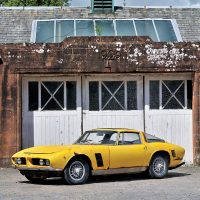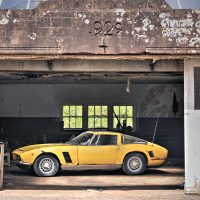The Grifo GL offered here is one of about 34 right-hand-drive Series I examples produced. It was acquired by the current owner as a solid original car in 1986 and was subsequently sent to a restorer to be refinished in burgundy. The work was never carried out, and the car spent over two decades in storage.
While in need of significant restoration, it remains very complete, down to the dashboard instruments and the exterior trim; even the rear bumpers removed in preparation for the beginning of the restoration remain in the trunk, where they were placed decades before. The 327 V8 is original to the car, while the 4-speed transmission is believed to be original to the car.
SCM Analysis
Detailing
| Vehicle: | 1967 Iso Grifo GL Series I |
| Years Produced: | 1965–74 |
| Number Produced: | 412 |
| Original List Price: | $13,750 |
| SCM Valuation: | Median to date, $390,500; high sale, $1,186,220 |
| Tune Up Cost: | $250 |
| Chassis Number Location: | Metal plate on top of right front shock tower |
| Engine Number Location: | Stamped in block ahead of passenger’s cylinder head |
| Club Info: | Iso & Bizzarrini Owner’s Club |
| Website: | http://www.isobizclub.com |
| Alternatives: | 1965–69 Bizzarrini 5300 Strada, 1966–68 Ferrari 330 GTC, 1968–73 Ferrari 365 GTB/4 Daytona |
| Investment Grade: | B |
This car, Lot 108, sold for $172,592, including buyer’s premium, at RM Sotheby’s London auction at Battersea Evolution in London, England, on September 7, 2016.
So where do we begin? For starters, the math might pencil out on this one. The car is complete, although the parts order to finish it to a high standard will be sizable. Mechanically there isn’t anything too challenging and the trim work is pretty straightforward. The most obvious issue, however, is rot. While I have not seen the car in person, RM Sotheby’s photos do seem to show corrosion on nearly every panel, and Grifos are known for having rust issues with their pressed-steel unibodies. The metal work alone will cost a substantial amount of time and money.
With an all-in price of $172,592 paid, adding $150,000 to $300,000 in restoration expense seems to give you the current spread of market results for the model. But managing this car’s restoration budget will be paramount if it’s strictly a numbers game.
The more pressing question, perhaps, is why buy and restore this one?
Owning a myth
The lure of a “barn find,” or “garage find” isn’t hard to explain. It’s the idea that something has been hidden away, waiting to be found. For me it’s a reminder that there are still cars out there that we don’t know about.
The discovery aspect is what draws us in. We’ve seen everything come to market under the barn-find distinction, including a Tucker, a 250 SWB California, a submerged Bugatti Brescia, and loads of stuff like this Grifo. Go to any car show and it’s the barn find — not the 100-point restoration — that draws a crowd.
Seemingly, though, the prices paid for these barn-found vehicles are only loosely based on market data. I‘m continually surprised by what they are capable of achieving at auction. But the draw, and the premium, is fleeting. Similarly, one could argue that paying more for a one-owner car doesn’t pan out when you turn to sell it.
From the vendor’s perspective, however, it’s brilliant. And in most cases, it works. Some barn-find examples have brought as much as — or more than — driver-quality comparables.
Untouched versus neglected
But let’s get a little more articulate about the difference between original and unrestored.
Seemingly, “original” and “unrestored” are one and the same when you look at market results for barn finds. So why do dried-out engine seals, a fuel system full of sludge, and a layer of dust add value? If we started calling cars “cared for” and “neglected,” would it change their values?
Decades ago, collectors and restorers sought only the best original examples because they proved the easiest to restore. This adage led to the ruin of many wonderful, original automobiles. Fortunately, in the more recent past, the merits of an original car have become better understood.
If you think the notion of a restoration ruining an original car is harsh, I urge you to drive a well-restored example and a good original example of anything and tell me what you think. The two cars, while ostensibly the same make and model, will be quite different. It’s night and day.
To highlight the difference in terms of value, Gooding sold what was perhaps the finest original Iso Grifo extant for $510,500 at Pebble Beach this past August. Under a month later, our subject car brought $173,000. All things considered, the original car was, and will remain, the better buy.
While the project car exceeded expectations, I’m happy to see that in this particular comparison, the market spoke with reason. With barn finds, that hasn’t always been the case.
How do you want to spend your time?
Some of the best values in today’s market are cars most people would consider “drivers.” Whether it’s a car that’s partly original or just an older restoration, people seem to be overlooking the inherent qualities of a car based solely on condition.
Don’t get me wrong. Well-kept-original or well-restored cars are worth the premium. Just make sure you’re weighing all your options and giving a good honest car a fair shake. Too often an older restoration and a project get lumped into the same category — one in which the buyer thinks he or she is signing up for a total restoration. That doesn’t have to be the case.
But people’s hesitations are well founded. Today, the most costly part of a restoration is not necessarily monetary; it’s the time commitment. Talk to any good restorer — they’re backed up for years.
Value in experience
Iso Grifos come up for sale with some regularity. I don’t see any inherent value in having bought this particular example versus another, and it’s important to note that a buyer is forfeiting a serious amount of time in this job for a replicable outcome. But maybe it has something to do with enjoying the process. Some people simply like the adventure of restoring and properly sorting a car.
RM Sotheby’s London sale saw some spirited bidding and strong results across the board, so it’s not surprising that this car sold for multiples of its pre-sale estimate. And we could have argued that figure was light to begin with.
If anything, the “barn find” exemplifies the market’s true colors. There is plenty of impulse involved, and in the past five-odd years, it has been hard to make a mistake buying anything.
That won’t always be the case, though, so adopting an educated approach is all the more valuable. As long as the new owner of this Grifo had a clear picture of why he or she was raising a paddle — and what the road ahead holds — this was a decent sale for both parties. ♦
(Introductory description courtesy of RM Sotheby’s.)
